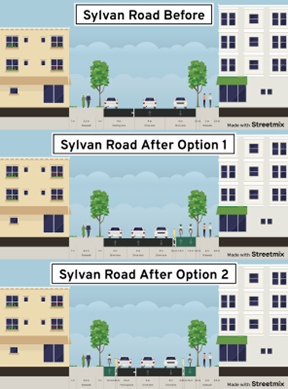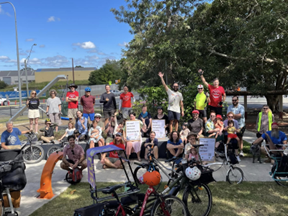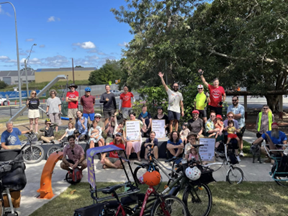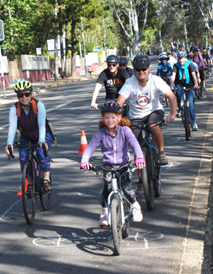Streets for people: Make cycling safe
Freedom to move with more protected bike and scooter lanes.
Driving around Brisbane is slower and more expensive than ever. Bikes and ebikes are far cheaper than cars, quicker for many trips, and more fun to boot.
But most of us don’t have a choice, because most roads in Brisbane are not safe for any but the bravest cyclists. That’s because under the LNP, Brisbane City Council builds this city for cars alone.
Cars dominate local shopping strips and school drop-offs across most of the city, making those places more hostile for walking and more dangerous for everyone.
Many people simply don’t have a car or a driving licence because of their age, disability or life circumstances but they shouldn’t be locked into isolation. We can build world-class, safe, protected bikeways across this city and give everybody freedom to choose how they move around Brisbane.
A Greens-led Brisbane City Council will:
- Give residents the freedom to get around without a car by building 35 km of protected bike and scooter lanes on 15 high priority corridors, and starting planning for more.
- Create direct connections by prioritising bike and scooter lanes to schools, hospitals, community facilities and shops and modernising Council’s street design standards.
Freedom to get around car-free
Our plan will give residents the freedom to choose how to get around our city. Some people will still need to drive, but every new cyclist or scooter rider means one less car on the road.
It should be cheaper, safer, and easier to get around our city. Many people rely on their car because there simply aren’t other safe options. Only 13% of trips in Brisbane are by bike or walking, while 75% are by car. (1)
Our plan helps everyone - from less confident drivers, to parents acting as a taxi service, to people who would like to ride if it was safer. People should have safe options for getting around their city.
High priority bike lanes
Thanks to Greens pressure and community, Council has already rolled out some successful protected bike and scooter lanes including the Woolloongabba Bikeway on Stanley St and Annerley Rd, as well as the CityLink bikeway in the CBD.
The Greens would build on that success, delivering over 35km of urgently needed protected bike paths along key corridors for $360 million over 4 years. The new protected bike corridors would be:
North
- Complete the North Brisbane Bikeway, Wooloowin to Toombul
- Kedron Brook Road via Wilston Village
- Viola Place Link
West
- Lambert Rd, Indooroopilly
- Moggill Road, Toowong to Kenmore
- Sylvan Rd, Toowong
South
- Annerley Road, Dutton Park to Annerley Junction
- Main Street, Woolloongabba to Kangaroo Point footbridge
- Montague Road, West End/South Brisbane
- Vulture Street, Woolloongabba to West End
East
- Stanley Street, Norman Park to Woolloongabba
- Wynnum Road, Norman Park to Cannon Hill
Centre
- Ann St from the CBD to the Valley and Newstead
- Melbourne Street, South Brisbane
- Grey Street, South Brisbane
This map shows the Greens’ planned bike and scooter corridors, plus existing bikeways, shared paths and protected bike lanes.
Our plan is costed based on the successful North Brisbane Bikeway stages 2 and 3, as well as the Woolloongabba bikeway. It is based on the assumption that floating bus stops, and both major and minor intersection upgrades would be built along these bike corridors to greatly improve safety. (2)
Our plan adopts the high priority bikeway projects proposed by the grassroots alliance of Brisbane-based bicycle user groups.

Example: Two concept options for safe, protected bike and scooter lanes on Sylvan Rd, Toowong.

Example: Concept layout for protected bike and scooter lanes on Ann St, CBD.
Direct connections on main roads
The Greens will also prioritise direct bike connections to key destinations instead of long, winding routes via creeks and back streets.
In practice, this means building bikeways directly to the places that people want to go, generally along major roads and high streets rather than only using indirect, poorly lit routes through parks and along creek corridors.
It also means making use of existing wide road corridors by simply adding protected bike and scooter lanes and slightly narrowing car lanes, removing some on-street parking, or removing an unnecessary traffic lane.
Slightly narrower traffic lanes are actually safer for drivers, because they discourage dangerous behaviour like speeding. Combined with protected bike and scooter lanes, the entire street environment will become far less dangerous, and more inviting to local foot traffic - ideal for local high streets. (3)
People want bike lanes
Brisbane has a vibrant cycling community. Local grassroots groups are pushing to make cycling safe, practical and fun. The LNP has ignored these calls for protected bike lanes across the city.

Local residents are calling for protected bike lanes on Annerley Rd but the LNP has failed to act.

Local residents with Greens MP Michael Berkman calling for protected bike lanes on Lambert Rd Indooroopilly.
A cleaner, safer city
Making it possible to drive less means less need for excessive car parking which currently occupies valuable street space. That space could be converted to verge gardens, shady trees and footpath dining on local high streets.
Shifting how we get around cuts climate pollution. Less particulate pollution from tyres and exhaust means cleaner air, and fewer cars means quieter streets.
Funding streets for cycling
Bikeways are very good value for money, and much cheaper to maintain than roads. The $90 million annual investment would be reallocated away from wasteful road projects which just generate more traffic.
Just three recent road widening projects are set to cost Council almost $1 billion:
- Adding two extra lanes to just 650 metres of Lytton Road cost Council $115 million,
- Widening just 3km of Kingsford Smith Drive cost $635 million,
- The wasteful and disruptive Moggill Rd / Coonan St “upgrade” has blown out again to $234 million.
We would also make big developers pay their fair share and reverse the LNP’s big tax cut for big developers to create a better life in this city for everyone.
Designing for the future
Cities like Paris, and Montreal have used the few short years since COVID to transform their streets into cycling-friendly spaces, but the LNP Council has remained stuck in the past.
We can’t keep shovelling money into expensive road-widening projects, and we know that adding car lanes just creates bigger traffic jams - a phenomenon called induced demand.
On top of the urgent bikeway projects, we would start planning for major corridors with very limited bike facilities, including Logan Rd, Fairfield Rd, Rochedale Rd and Gympie Rd.
We would also update Council’s design standards for all streets and intersections, so that bike lanes, footpaths and safe crossings are included as standard. As roads are gradually resurfaced and intersections upgraded, these upgrades will be added at minimal additional cost. That means safer streets across the whole city - not just a few corridors.

Protected bike lanes make cycling safe for kids.
(1) Queensland Household Travel Survey.